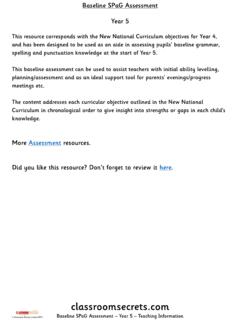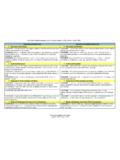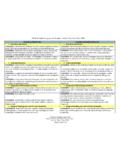Transcription of SATs Year 6 Parents’ Grammar, Punctuation and Vocabulary
1 SATs Year 6 parents '. grammar , Punctuation and Vocabulary Practice and Revision Activity Booklet Contents 1 Information and Guidance for parents page 3. 2 G1: Grammatical Terms and Word Classes pages 4-15. 3 G2: Functions of Sentences pages 16-19. 4 G3: Combining Words, Phrases and Clauses pages 20-25. 5 G4: Verb Forms, Tense and Consistency pages 26-33. 6 G5: Punctuation page 34-41. 7 G6: Vocabulary pages 42-46. 8 G7: Standard English and Formality pages 47-50. 9 Answers pages 51-69. Page 2 of 69. 1 Information and Guidance for parents This booklet is intended to help you navigate your way through the terminology of the KS2 grammar , Punctuation and Vocabulary test (often referred to as one of the SPAG' assessments) so that you can support your child during this busy (and sometimes daunting) period of their life. The terminology of the SPAG test can often be a minefield for parents , who are often not familiar with the current curriculum in school.
2 You may have overheard your child using phrases like fronted adverbials, relative clauses, subordinating conjunctions, the subject and object of a sentence, and wondered what they all mean? This booklet is intended as a guide to the terminology of the grammar , Punctuation and Vocabulary test so that you, and your child, can use it as a revision reference in the build to their KS2 SATs assessments. Throughout the booklet, you will find explanations of the areas tested within the assessment with example questions in each section. How to Use This Booklet Each section in this booklet refers to one of the areas (or domains) tested in the English grammar , Punctuation and Vocabulary ' or Paper 1' booklet. Read and discuss each section with your child and check their understanding of the terminology. At the end of each section, there are some SATs-style questions to see if your child can apply their knowledge.
3 See if your child can answer each question independently first and then, if necessary, discuss the answer using the revision notes in the booklet to support them. By using the questions and discussing each answer with your child, you'll identify areas of the curriculum they need further support with. You can then use resources on the Twinkl website to further practise this area of the curriculum. For example, your child may struggle recognising and understanding the passive voice, therefore you could search for other passive voice resources on the Twinkl website. There are also some resources highlighted in this booklet with direct links to the Twinkl website. What Is My Child Being Tested On? The Key Stage 2 English grammar , Punctuation and Spelling assessment comprises of two papers. Paper 1. is the grammar , Punctuation and Vocabulary test and Paper 2 is a separate Spelling test.
4 This booklet deals only with the content found within Paper 1. For support with the KS2 Spelling Test, please use the SATs: Year 6 parents ' Spelling Practice and Revision Activity Pack. The grammar , Punctuation and Vocabulary test covers seven different content areas, which are listed in the table below: Each of the content areas above is a broad G1 Grammatical terms / word classes term for several sub-domains that children will G2 Functions of sentences learn throughout their KS2 education ( the G3 Combining words, phrases and clauses G1 content domain is split up further into Nouns, Verbs, etc.). The test content is G4 Verb forms, tenses and consistency drawn from the content of the entire programme G5 Punctuation of study for English. Due to the extent of the topics covered, not every aspect could possibly G6 Vocabulary be tested each year, therefore the questions do G7 Standard English and formality vary from year to year.
5 Page 3 of 69. 2 G1: Grammatical Terms and Word Classes Nouns Nouns are naming words. You need to know the different types of nouns and be able to spot them in a sentence. Use this table to help you identify different types of nouns: These are straightforward, everyday words for things. They can be singular or plural. They are Common Nouns words like: chair, pen, pencil, bike, house, monkey, elephant, fish, cheeseburger Proper nouns are the names for particular people, places, or things. They also include days and months. Proper nouns should always start with a Proper Nouns capital letter. River Mersey, London, Mr Smith, Scarlett, Rohail, Tuesday, December, Sandown Street Collective nouns are the special names for groups. Collective a crowd of people, a herd of reindeer, a gaggle of Nouns geese, a swarm of bees, an army, a pack of wolves These are names of things you can't see, touch, taste, smell or hear.
6 They are used to name ideas Abstract Nouns and concepts such as: friendship, love, fear, education, politeness, beauty For further activities and resources on nouns, please see: Identifying Different Types of Nouns Lesson Teaching Pack What Are Nouns PowerPoint Spot The Pronouns and Nouns Differentiated Activity Sheet What Is a Proper Noun Resource Pack Page 4 of 69. G1: Grammatical Terms and Word Classes Verbs Verbs are words that tell us what is happening in a sentence. They are often referred to as doing or being words. If a sentence doesn't have a verb, it's NOT a sentence. Here are some examples of verbs in sentences. Stop the car! The boy ran across the playground. They eat strange food. She is painting the wall. Sentences can contain more than one verb! The Verb To Be' To be or A tricky one for children is the verb to be' as they don't always not to be?
7 Recognise it as a verb. That's why it is important that verbs are referred to as doing and being words. To be' is an irregular verb so use the table below to help you identify it in its different tense forms. The verb to be'. 1st person present I am 2nd person present you are 3rd person present he is, she is, it is 1st person plural present we are 2nd person plural present you are 3rd person plural present they are 1st person past I was 2nd person past you were 3rd person past he was, she was, it was 1st person plural past we were 2nd person plural past you were 3rd person plural past they were The different forms of to be' will sometimes appear in sentences with another main verb, Ben is playing football' or During yesterday's lesson, we were writing stories.'. For more support with verbs see: Verbs PowerPoint Using the Verb To Be' Present and Past Tense Page 5 of 69.
8 G1: Grammatical Terms and Word Classes Adjectives Adjectives are words used to describe nouns. A large, black cat climbed along the high wall. It is the Spanish flag. A colossal giant. The house was in pristine condition. Adjectives can be used to describe: colour, size, shape, condition, age, personality, texture, feelings, appearance and origin/nationality. Comparative and Superlative Adjectives Adjectives can also be used compare things. These are called comparatives'. They can tell you if something is bigger, better, smarter and so on. You often add -er to make comparatives but sometimes the words more' or less' are used too. The new car was smaller than her last. She was happier after dinner. Jack ate the smaller slice. She is less thoughtful than her brother. The superlative' is used to show something is the most, least, best or worst. Sometimes the words the most' and the least' are used to make the superlative.
9 Everest is the highest mountain in the world. It was the most wonderful sight he'd seen. For more support with adjectives see: Adjectives Activity Sheet Resource Pack Comparatives and Superlatives Activity Sheet Page 6 of 69. G1: Grammatical Terms and Word Classes Co-ordinating Conjunctions Conjunctions are words used to join clauses or sentences together. Firstly, children are taught co-ordinating conjunctions that are used to link two separate sentences together. They are often taught the acronym FANBOYS' to remember them: for and nor but yet so or Both parts of the sentence (or main clauses) on either side of the conjunction would make sense on their own. It was getting late and Mia had to get ready for bed. Nell needed a shower so she turned on the water. Subordinating Conjunctions Throughout KS2, children are taught to use subordinating conjunctions to create complex (multi-clause sentences).
10 A good way to remember some of the main subordinating conjunctions is: I SAW A WABUB! If Since As When Although While After Before Until Because Subordinating conjunctions are used at the start of subordinate clauses. The children were allowed to play until it got dark. Put up the posters before the parents arrive. As she had won the race, she was happy. Subordinate clauses do not make sense on their own. They can appear at the beginning and at the end of sentences. For more support with subordinating conjunctions see: What is a Subordinating Conjunction Resource Pack Identifying Subordinating and Coordinating Connectives Activity Sheets Page 7 of 69. G1: Grammatical Terms and Word Classes Pronouns Pronouns are words that are used to replace a noun or a noun phrase. Without pronouns, spoken and written English would be very repetitive. For example: Steven likes to play football.






